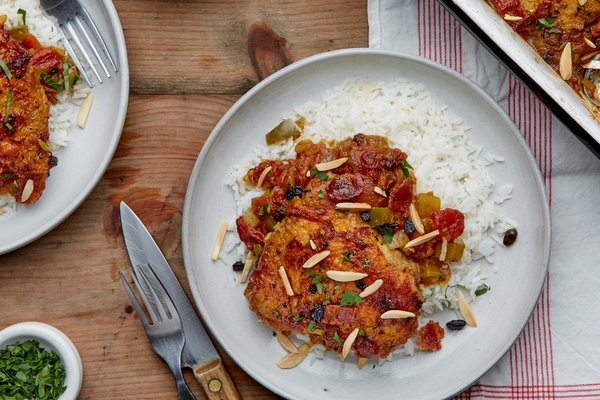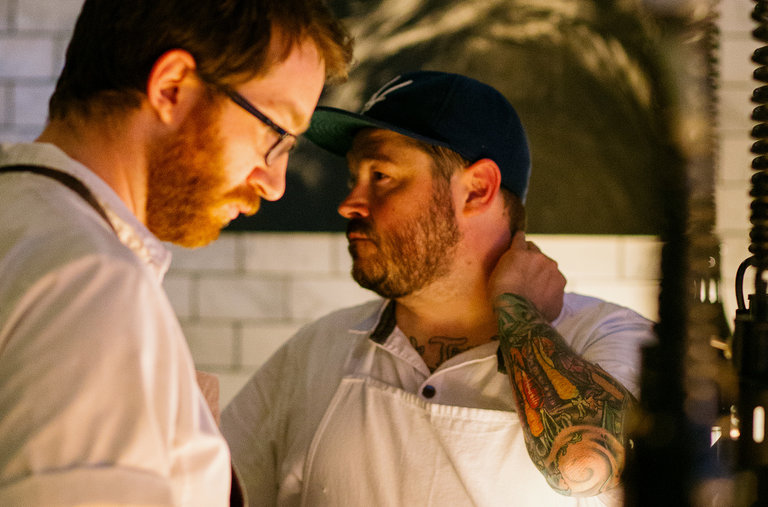CHARLESTON, S.C. — Nathalie Dupree, the doyenne of Southern cooking, sat at a sunny table near the window at Hominy Grill in late April, a few days before it would serve its last biscuit, and insisted on an order of shrimp and okra beignets.
Ms. Dupree, 79, also required a plate of curry-scented Country Captain and some shrimp bog, the wetter, milder cousin to Louisiana’s jambalaya.
She had a waiter bring bowls of lima beans and tomato pudding, then a slice each of coconut cake and buttermilk pie. The dense chocolate pudding with its whipped cream cap had already sold out for the day. But never mind: She had a cup of it stashed in her home not too far away.
“I just don’t know who is ever going to make these dishes in this way ever again,” she said. “This is the end of something.”
But, as many fans of eating in Charleston are asking these days, of what?

The airy shrimp and okra beignets, served atop a spoonful of cilantro sour cream and topped with tomato salsa, were one of the sleeper hits of the Hominy Grill menu.CreditLeslie Ryann McKellar for The New York Times
By itself, the closing of a 23-year-old restaurant in a city whose dining culture stretches back to the George Washington administration doesn’t signify the death of anything other than a place whose chef and owner, Robert Stehling, 55, was ready to end a good run and move on to something that didn’t require as much effort.
But Hominy Grill was a seminal place, a bastion of Lowcountry cooking that helped turn this city into a culinary destination. It closed in the same month that the chef Sean Brock officially severed all ties to the restaurants that had vaulted him to national fame, including McCrady’s and especially Husk, where he drilled down into the African roots of Southern agriculture and made a religion out of cast-iron cornbread.
Mr. Brock opened Husk in 2010 with the swagger of a prizefighter, promising to show that Southern cuisine was the greatest in the world. He came close, leading Southern food into a new chapter begun by Hominy Grill, the original Watershed restaurant in Atlanta, and before them, Highlands Bar & Grill in Birmingham, Ala., and Crook’s Corner in Chapel Hill, N.C.
Mr. Brock, 41, has decamped to Nashville. He recently became a father, and continues to dedicate himself to his sobriety and physical health. He is creating a restaurant inspired by his Appalachian roots, and working on an app called SideGig, which will link cooks, servers and dishwashers with restaurants that need someone to fill in for a shift or two.
The departures of Mr. Brock and Hominy Grill have turned up the heat on a discussion that was already brewing in Charleston, a jewel-box city built on hospitality and rice culture but also on a brutal history as the nation’s capital of the slave trade. At least 100,000 captured Africans passed through Charleston Harbor on their way to being sold as slaves.
“I don’t know what the city is right now,” said B.J. Dennis, a chef whose cooking centers on the Gullah Geechee food traditions developed by West Africans who were enslaved along the southeastern Atlantic coast. His ancestors come from a Gullah Geechee community in Wando, outside Charleston
“We lost our culinary identity, and I am not just talking about Gullah Geechee but about the whole Lowcountry cuisine,” Mr. Dennis said. “The locals of Charleston have been pushed to the wayside, the black locals and the white locals, for this new wave of tourists and people moving here.”
He is one of many Charlestonians who complain that the city is crowded with concept restaurants serving $18 cocktails and expensive, mediocre interpretations of Lowcountry standards.
“It’s like, let me get some grits and put a million things in it and a bunch of cheese and some duck that doesn’t even make sense on the plate, and charge you $30 for it,” he said. “Basically, I think we’re just a Southern Brooklyn. A Williamsburg.”
When Hominy Grill opened in 1996, the city’s Navy base and shipyard was closing. Civic leaders turned with new dedication to tourism. To say they succeeded is an understatement.
More than seven million tourists a year crowd Charleston’s charming streets, some with homes that date to the early 1700s. Even on a weekday night, the city seems filled with bachelorettes tumbling out of Uber cars, culinary tourists angling for tables and wide-eyed cruise ship passengers, 225,000 of whom arrived in 2018.
The feel-good machine doesn’t seem to stop. The Charleston Wine & Food Festival, which Ms. Dupree helped start in 2006, packs in 30,000 people each year, and is so popular that NBC’s “Today” show broadcast live from the event in March. For eight years in a row, the city has topped Condé Nast Traveler’s list of the best small American cities. Southern Living readers picked it as the South’s best city for 2019. It has held the top spot on Travel & Leisure magazine’s best-cities list for six years in a row.
As a result, the city is in the middle of the biggest hotel and restaurant boom in its history.
The restaurants Mr. Brock once presided over have changed, too, even though the same restaurant group still owns them. Husk has spawned sister restaurants in Greenville, S.C., and Nashville, neither of which he is involved with anymore. McCrady’s, a historic restaurant that Mr. Brock helped reinvent in 2006, used to feature dishes like his beet au poivre, in which the vegetable was pressure-cooked, dehydrated and coated in peppercorns so it presented like dry-aged New York strip steak. Now the only beet dish on the menu is a salad dressed in raspberry vinaigrette.
Next door at Minero, the Mexican restaurant he started, a sandwich board on the street beckons customers with the promise of tequila and TV, not the nixtamalized masa handmade from heirloom corn.
“You look at the number of restaurants and the amount of people who are coming and the size of the talent pool, and it doesn’t add up anymore,” Mr. Brock said.
He is not as concerned as some. “The great adjustment happening in Charleston isn’t necessarily a bad thing,” he said. “It will be easier to sift through the ashes and see what’s important. What’s left will be the thing that moves it forward.”
Still, he and others worry about places like Hannibal’s Kitchen, Nana’s Seafood & Soul and Martha Lou’s Kitchen, small restaurants whose plates of crab rice, steamed garlic blue crabs and fried chicken offer a direct line to the region’s Gullah Geechee ancestors.
“We’ll be fine without 9,000 Italian restaurants in Charleston,” Mr. Brock said, “but we can’t take our finger off the pulse of those institutions.”
Kenyatta McNeil, the owner of Nana’s, has watched the change sweep through the block where his little three-table shop sits. He grew up in a nearby housing project. The neighborhood has gone from mostly black to mostly white, and 75 percent of his customers are now tourists.
To bolster business at his and other soul-food institutions in and around downtown Charleston, he started a tour called Geechee Eats Food Shuttle in 2017. It hasn’t really taken off, he said.
“The power in Charleston has always been one way and not our way,” Mr. McNeil said. “It’s all about branding now, and black restaurants in Charleston aren’t branding ourselves the way the white restaurants do.”
Tourism has changed life in central Charleston so drastically that many people he knows have moved to North Charleston, near Charleston International Airport. Mr. McNeil plans to open a second location there.
Real-estate prices and crowds have also driven growth in a workaday district between North Charleston and downtown that most people call the Neck but developers have christened NoMo. The food scene there is not dissimilar to those in other cities where global flavors, craft breweries and food trucks appeal to young diners.
The area’s star is Butcher & Bee, which started as a small sandwich shop on King Street. In 2016, it moved to a larger, more industrial space in NoMo where a bakery in the back turns out chewy, charred pita perfect for scooping up whipped feta covered in fermented honey and black pepper.
The owners also opened a food hall called Workshop a short drive away that features a rotating cast of players. You can buy $7 milkshakes, play trivia on Wednesday nights and sample dishes that mix Thai and Southern food. At noon on a recent Thursday, the hall was all but empty.
Hanna Raskin has been documenting the city’s changes for six years as the food editor and restaurant critic for the local newspaper, the Post and Courier. Lately, it hasn’t been pretty.
Ms. Raskin has come under fire from some powerful figures in the city’s restaurant community who say she is too critical. In March, Malagón, a cozy Spanish tapas restaurant and market in the newly hip Cannonborough-Elliotborough neighborhood, told her she would not be allowed in.
In an email to her, an owner, Patrick Panella, cited her negative review of another restaurant he owns with his wife, Fanny: “We do not wish to subject ourselves to the type of personal insults or inaccuracies that were on display when you reviewed Chez Nous almost five years ago.”
Ms. Raskin sent back an email explaining that restaurant owners don’t get to dictate newspaper coverage. Then she wrote a workaround review of Malagón, based on online photos and food sneaked out to her by friends.
Over snacks in the bar at Tradd’s, an elegant but comfortable new downtown spot whose owners also were unhappy with her review of their restaurant, Ms. Raskin pondered whether restaurateurs would have pushed back so hard in the days before Charleston became a dining darling.
“I do think it’s a matter of inflated ego,” she said. “Charleston is at a crossroads here. It needs to decide if it wants to just be a pretty place or if it wants to be a significant contributor to food as a whole.”
A waiter brought a tin of $100 caviar from North Carolina in a bowl of ice glowing blue from the light of a votive candle. Is this Charleston dining?
“It is now,” she said.
Tradd Newton, a grandson of the founder of the Piggly Wiggly Carolina Company who owns Tradd’s and the seafood restaurant Fleet Landing with his wife, Weesie, doesn’t think Charleston is in the middle of a culinary identity crisis. It’s just going through a thinning out.
That’s one reason he decided on a more continental menu for Tradd’s. “There’s enough Southern cuisine and enough Southern restaurants that have opened in the last 10 years,” he said.
Yes, he added, there is a wider variety of tourists to contend with. Finding enough qualified employees is a challenge. Parking is awful and rents are high. “But other cities have grown and thrived and we can, too,” he said. “I think everybody’s going to be O.K.”
Charleston doesn’t lack for well-regarded restaurants. The chef Mike Lata continues to show his mastery of seafood at the Ordinary and high-level culinary agility at FIG. Last year, a New York couple opened Tu, serving food from the Indian subcontinent, as a companion to their popular Xiao Bao Biscuit. Coming soon is an outpost of Big Bad Breakfast from the Mississippi chef John Currence, who once cooked at Crook’s Corner.
Matt Lee, the cookbook author and a resident of Charleston who chronicles Southern food with his brother, Ted, said the city was simply suffering from the kind of adjustments that might come when the most popular student in high school heads off to college.
“The recent closings/openings/‘reconceptings’ and chef moves are pretty typical for any growing city where there’s an extreme staffing shortage and seemingly no end of investor money coming in,” he wrote in an email. “Absent any major economic shifts, it appears to be just usual turnover as the restaurant scene and its personnel evolve.”
Back at Hominy Grill, talk around the table was not as upbeat. The city’s restaurant game has changed forever, said Nunally Kersh, Mr. Stehling’s wife. “It’s not about the chefs anymore,” she said. “You can’t just come with a dollar and dream.”
The two met when they were college kids working for the chef Bill Neal, who opened Crook’s Corner in 1982, and is credited with turning the fisherman’s breakfast of shrimp and grits into a Southern restaurant standard.
The couple moved to New York, where Mr. Stehling spent almost a decade cooking, including at Home in Greenwich Village. In the mid-1990s, Ms. Kersh took a job as the producer of the Spoleto Festival, and they returned to Charleston. Mr. Stehling decided to open a restaurant that would carry on the legacy of Mr. Neal, who died in 1991. Charleston was a place where people understood the style of Southern food Mr. Stehling wanted to cook.
“I didn’t want to explain hoppin’ John for the rest of my life,” he said.
Back then, Ms. Kersh and Mr. Stehling could have bought the building for $350,000, but they couldn’t afford it. By the time they could, in 2008, it cost $1.8 million. A recent appraisal put its value at $2.5 million, Ms. Kersh said.
The neighborhood has been transformed. In the beginning, the staff could walk to work, and customers drove; now it’s the other way around. The staff can’t afford to live in the area anymore.
The conversation about the role food plays in Charleston has changed, too, particularly as the city moves deeper into reckoning with its past. The 2015 murders of nine black parishioners by a young white supremacist laid bare the work left to do.
In two years, the International African American Museum will open. Since as many as 60 percent of the nation’s African-Americans may be able to trace their roots here, it is likely to bring a new kind of tourist to town. The project would be a perfect canvas for a restaurant that explores black food in the way Sweet Home Café does at the National Museum of African American History and Culture in Washington, D.C.
Meanwhile, there will be one less place for coconut cake and cornbread.
“Charleston is still having complicated discussions about race and its history and its food,” Mr. Stehling said. “That will continue to happen, whether we are here or not.”
Follow NYT Food on Twitter and NYT Cooking on Instagram, Facebook, YouTube and Pinterest. Get regular updates from NYT Cooking, with recipe suggestions, cooking tips and shopping advice.







